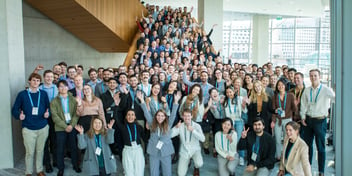Why this utility is focusing on diversity in its future leaders
Recent workplace figures suggest Australia’s business leadership is still predominantly male, but one Australian water utility is bucking the trend.
SA Water recently announced the appointment of Jacqueline Guerin as its Chief Financial Officer (CFO), which now makes the majority of the utility’s leadership team female – making up five of seven positions.
According to 2020 insights from Australia’s Workplace Gender Equality Agency, women hold just 14.1% of chair positions and represent 17.1% of CEOs in the country.
While the Australian water sector performs slightly better – nearly 30% of water utility CEOs and managing directors are female, and women hold nearly 38% of chair positions – there’s still a significant gap in female leadership.
But for how much longer? At SA Water, there are more than a dozen women leading teams in traditionally male-dominated areas such as science, engineering and field services, and 50% of its Non-Executive Board Directors are female.
But the newly appointed CFO says equality in leadership is about more than just gender.
“Having more women around the table is really important, but you also need people from different backgrounds, ethnicities, physical abilities and age groups,” Guerin said.
“From my own professional experience, a greater range of perspectives provides diversity of thought, leading to better ideas and decisions.”
Equal opportunity
Guerin said the water sector was improving, and that these improvements were a direct result of ensuring equal opportunity.
“In the water sector in particular – where I’ve worked for the past eight years – I am seeing improvements, with tailored industry development programs and policies, and outward support from industry leaders,” she said.
“It’s terrific to know SA Water has a diversity and inclusion strategy which actively seeks opportunities for women, as well as new and emerging employees, and prioritises Aboriginal and Torres Strait Islander employment and retention, and a flexible and inclusive workforce.
"It’s this strategy that led to SA Water achieving a zero gender pay gap in 2017, compared to the current national average of 13.9%. This kind of achievement only comes when you remove potentially ingrained inequities, tackle unconscious bias and put processes in place around contract and pay assessments.”
SA Water General Manager of Asset, Operations and Delivery Amanda Lewry said she was proud to be fronting infrastructure, laboratory and engineering, as it offered the opportunity for her to attract and retain more women in jobs that have historically been male-dominated.
“Across my professional career, I got used to being the only female in the room, but since having children especially, I have thought what this unequal gender representation must look like to both young girls and boys,” Lewry said.
“When you don’t see anyone like you in a certain role, it’s difficult to aspire to that as a career.
"It’s important we provide opportunities and support our young people right from the beginning, at a school and tertiary level, to demonstrate there are genuine pathways to a variety of professions, no matter their gender.
“It’s a basic demand and supply model.”
Focus on the future
Lewry said SA Water intends to build on its equality efforts, with the aim to employ at least 60% female graduates by 2024.
“Currently, more than half of our STEM graduates, and 47% of total graduates, are female, so we’re well on track to reaching that goal,” she said.
The other female members of SA Water’s Senior Leadership Team include General Manager of Customers, Strategy and Innovation Anna Jackson, General Manager of Governance, Planning and Regulation Anne Westley, and General Manager of Customer Delivery Kerry Rowlands.
All three general managers agree on the importance of having female leaders and the need to take conscious action when improving diversity imbalances within the sector.
“Within our organisation, I see numerous examples of women who have gained leadership positions – including in STEM roles – through merit, and this is something to be celebrated, as they’re fantastic role models for the next generation,” Jackson said.
“In an ideal world, there would already be a diverse range of people in every recruitment process, leading effortlessly to a diverse workforce. Until that time, it’s important we take deliberate steps to clearly signal the value of diversity to employees, and to back that up with an inclusive workforce.”
Related podcast:
https://omny.fm/shows/australianwater/brendan-moore-on-creating-an-inclusive-workplace


